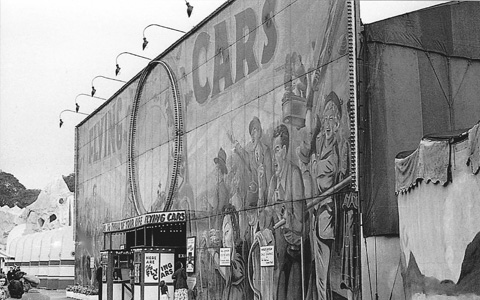|
|
|
| HOME ARTICLES GALLERIES ABOUT US FORUM LINKS CONTACT JOYLAND BOOKS | |
|
BATTERSEA FESTIVAL GARDENS 1951 (PAGE 4 OF 5) by Phil Gould Article: Added May 2011 |
|
|
In later years Botton Brothers were to become major players at the park but on the opening day their only large attraction was a Supercar Lighthouse Slip. This was painted predominantly in cream and blue. London showman Stanley Parkin brought along his open top Whip. This ride was no stranger to fairgoers in the city. Rhyl Amusements provided the Leaping Lena, which had previously operated at the resort‘s Marine Lake. A circular ride consisting of 10 jeeps with eccentric wheels causing the cars to leap as they moved around the platform. By all accounts this wasn’t a particular pleasant experience and the ride was not a great success. Superior Amusements of Morecambe were responsible for the Ghost Train at the park. In the middle of the park was a boating pool operated by J & T Maxwell of Southend. A fleet of 30 speed boats were harboured to entertain visitors and there was a 14ft Mississippi Showboat for party cruises. At one corner of the boating pool was a Cornish village backdrop and in the centre of the pool was an island complete with a lighthouse. For sailors who had worked up a thirst the Cremore Beer garden was handily built up along two sides of the pool. In between the boating pool and the Big Dipper were two very large attractions. The Rotor was presented by Max Myers. Londoners had already had a sneaky peek at what this novelty had to offer as a smaller version called the Ride-a-wall had been presented at the Christmas fair at Olympia the previous year. This version was huge in comparison. This ride had been invented in Germany by Ernst Hoffmeister, who was present at the opening ceremony. It had been built by well-known showland manufacturers Orton & Spooner of Burton-on-Trent. Riders entered halfway up a drum. They stood against the walls and the ride started to rotate. When it had reached a certain speed the floor would drop away leaving riders stuck to the wall. The fun could be watched by spectators from a three tier viewing gallery at the top of the drum. The front of the ride had cut out letters saying Rotor and had cartoon figures of people stuck to the wall. This attraction is still popular on fairgrounds today, albeit in much smaller versions, and is the only novelty that was introduced at Battersea that has stood the test of time. Another huge structure housed the Flying Cars. William Thompson of Blackpool operated the ride which was inside a booth that measured 100ft by 50ft. This contained a slowly revolving drum which was over 30 feet high. Inside the drum were five single seater motor cars which ran on independent tracks. These had grooves cut in them and when the riders applied their brakes the cars were carried around the drum, as long as the brake remained in place. Once this was released the car would fall backwards then move forwards in a swinging motion. Skilful riders could get cars to loop the loop. At either end of the booth were ramps where spectators could watch. The World’s Fair noted that the British patent had been applied for. It also pointed out that, despite having a pictorial front, the building was something of a ’ground blocker’ and it would have been much better suited on a side position. |
 The huge Rotor dominated the park. Picture: Horst Koch
|
|
|
|
|
THEMAGICEYE | Terms and Conditions | Privacy Policy | Contact Us |
|

